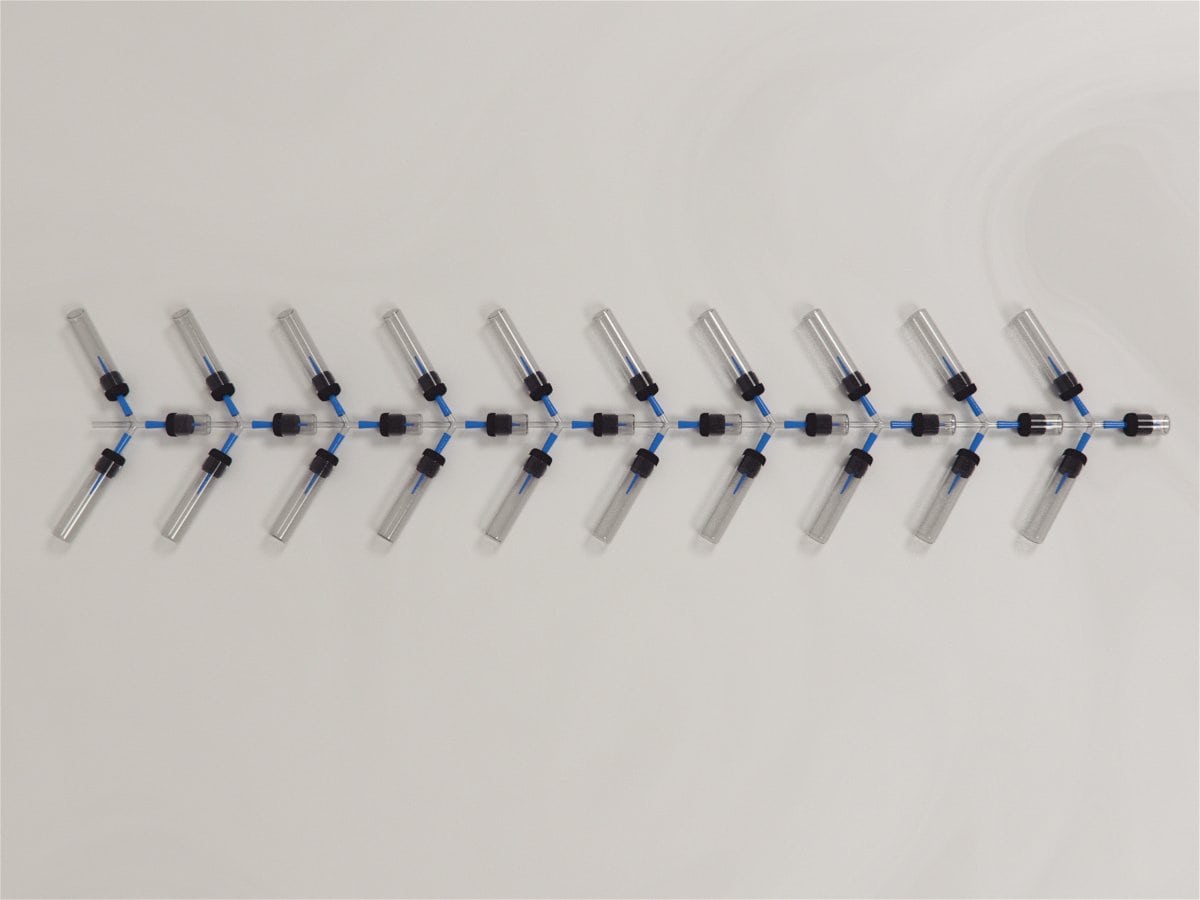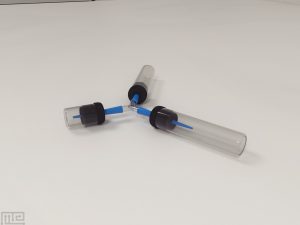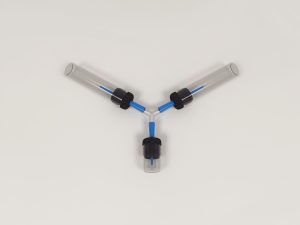Description
Drosophila Y Maze was originally described by Simonnet et al 2014 as a method to efficiently evaluate chemosensory responses in Drosophila. This methodology minimizes stress on the flies (from air flow, manipulation of the flies during the loading step, etc.) which potentially influences olfactory responses.
narrow pipette tips are assembled to prevent flies from returning once they make the vial choice as well as limit odorant diffusion in the Y Maze.
Small loading vials encourage choice making in the Y-maze to maximize participation of Drosophila.
The MazeEngineers apparatus is a Y-shape connector that connects to two glass vials and to a smaller plastic vial (loading vial). 1 ml pipette tips are assembled through the foam stoppers to link the connector to the three vials, creating a tightly sealed Y-maze. The MazeEngineers apparatus comes with 5 units of 10 connected Y mazes for a total of 100 Y Maze units.
Price & Dimensions
Drosophila Y Maze Apparatus
$ 1290
Per Month- 10 sets of 10 Y mazes
- 100 total Y Maze units
- Dimensions: 23cm x 15cm
Documentation
Introduction
The Drosophila Y-Maze is an adaptation of the traditional rodent maze, the Y-Maze, which in turn is a modification of the T-Maze. While the Y-Maze and the T-Maze are used for behavioral based testing of spatial learning and memory in rodents, the Drosophila Y-Maze is used in the assessment of olfactory perception. Olfactory perception investigations often prefer Drosophila Melanogaster models due to their similar cellular and molecular odor-coding strategy to mammals.
The experiments using the Drosophila Y-Maze utilizes the insect’s chemoreception abilities by subjecting them to different odors in the maze arms. This key sensory ability is a key factor for survival, providing necessary cues for detection of danger or food sources, social interactions and assisting in finding mates. Other Drosophila mazes include the Drosophila Maze Array, Drosophila Shallow Chamber, and Drosophila Olfactory Operant Conditioning.
The general design of the apparatuses includes three vials that serve as the holding and the choice arms of the Y-Maze. The vials are interconnected to each other using a connector and pipettes that allow one-way movement between the vials. Foam stoppers help create a tight seal around the vials. The apparatus can be connected to create an array of Y-Mazes.
Apparatus and Equipment
The Drosophila Y-Maze consists of 2 glass vials that serve as the trap-vials and are larger than the loading vial that is made of plastic. The small size of the loading vial is to encourage the subjects to enter the Y-Maze. A plastic Y-shaped connector is used to link the three vials using 1 ml pipette tips assembled through foam stoppers. The foam stoppers enable the creation of tight seals around the vials.
Training Protocol
For the assessment of olfactory perception in Drosophila, subjects aged 4 to 9 days are chosen. Before the experiment, they are starved for 16 to 18 hours in a glass tube with a wet paper towel at 25⁰C. Before beginning the experiment, the Y-Maze apparatus is cleaned by soaking it, dismantled, in RBS 35 MD overnight after which it is first rinsed with tap water followed by a final rinse with deionized water.
The experiment is performed under a far-red light setting, to prevent any visual cues from influencing the performance, and at a stable temperature of 25⁰C. Between each experiment, ventilate the area by regularly renewing the air of the room. Automated tracking and recording can be performed using software such as the Noldus Ethovision XT.
Assemble the dried apparatus with approximately 6 mm diameter filter paper soaked with 40 μl of odorant and solvent placed in the respective trap-vials. To load the flies into the loading-vial, use brief cooling with ice to anesthetize the subjects and limit unnecessary stress. Link all the vials via the pipette and connector assembly and allow at least 24 hours for the flies to participate in the task.
Assessment of Drosophila olfactory perception in a Y-Maze
Simonnet et al. (2014) used ten male Drosophila aged between 4 to 9 days per experiment to assess their chemosensory responses in a Y-Maze. Filter papers soaked with 40 μl of either acetic acid or phenylacetic acid (both diluted in distilled water; concentration: 10%) placed in one of the trap-vials was used to compare the olfactory perception of the subjects over a period of 24 hours. Subjects showed strong avoidance of acetic acid, whereas no such significant avoidance behavior was observed towards phenylacetic acid.
Sample Data
Strengths & Limitations
Strengths
The Drosophila Y-Maze is an effective tool to evaluate chemosensory responses in Drosophila. The pipette’s narrow tip allows only one-way entry and also limits odor diffusion in the Y-Maze vials (Simonnet et al., 2014). Further, the smaller loading vial forces the flies into the Y-Maze thus resulting in higher participation (Simonnet et al., 2014). These elements of design make the Y-maze more efficient and cost-effective. The Y-Maze apparatus can be easily modified to allow different stimuli such as light and electric shock. The Y-Maze can also be used as an array of Y-Mazes. The 24-hour period ensures maximum participation of the insects in the Y-Maze task.
Limitations
The Y-Maze, however, fails to mimic the natural environment. The locked design is an artificial set-up; thus, the task results may require further investigation. The handling process and the narrow passages of the pipette may add to the stress of the flies. The response generated by the Y-Maze, in comparison to a T-Maze are reflective rather than reflexive. Further, the plastic components may present an interfering olfactory stimulus. This can be overcome by designing the apparatus using only glass. Using a smaller sample size may result in a larger standard error. Improper lighting and ventilation may also affect the experiment results. It is also important to maintain a constant temperature during the experimental sessions.
Summary and Key Points
- The Drosophila Y-Maze is an adaptation of the rodent Y-Maze.
- The Drosophila Y-Maze is used to evaluate chemosensory responses.
- Drosophila Melanogaster have similar cellular and molecular odor-coding strategy as mammals.
- A smaller sized loading vial is used to force the Drosophila to attempt the Y-Maze.
- The pipettes allow only one-way locomotion and also limit odor diffusion.
- The Olfactory Index is calculated as the difference between the number of flies in odor tube and solvent tube, divided by the total number of loaded flies.
- Anesthetization by CO2 during this transfer is avoided due to its strong influence on behavior.
- Lighting should not generate unnecessary heat to avoid influencing the performance.
- The response elicited by the Y-Maze is reflective.
References
Simonnet, Megane M., Berthelot-Grosjean, Martine, Grosjean, Yael. (2014). Testing Drosophila Olfaction with a Y-maze Assay. Journal of Visualized Experiments, vol. 88 (e51241), p. 1-4.






